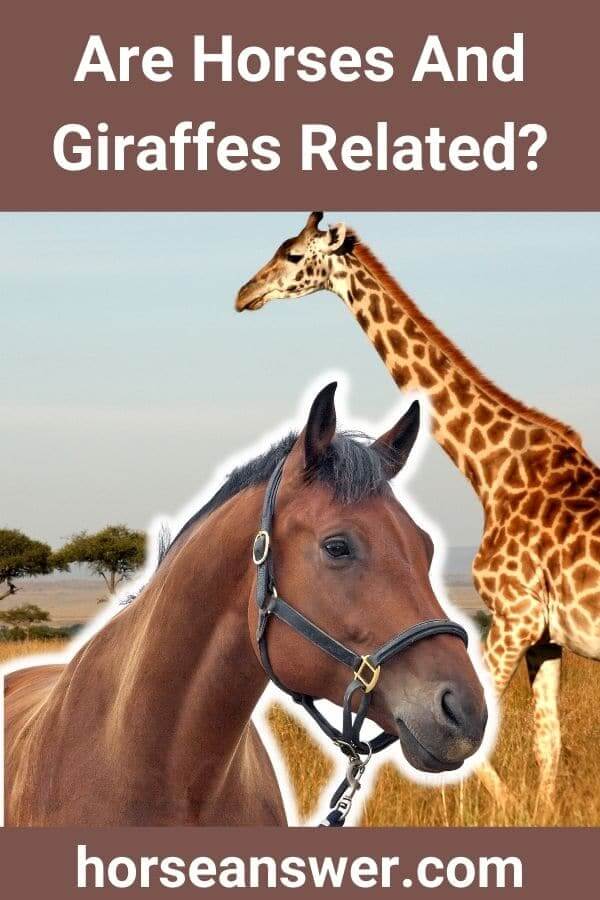Are Horses And Giraffes Related? (Find Out!)
The answer is no, horses and giraffes are not related. Although they are both four-legged mammals, horses and giraffes do not share recent enough ancestors. Because of this, they are generally not thought to be related and do not share much DNA.
Despite their differences, giraffes and horses both make great children’s storybook characters and have some things in common.
We will go into those similarities and the many differences in detail below.
Let’s get into it!

How are horses and giraffes similar?
Aside from the physical similarities of having four long legs, round bellies, and long necks compared to most animals, horses and giraffes are both herd animals.
They are social and live in groups, creating safety in numbers.
Both animals are also prey animals.
A giraffe’s main predators are lions, leopards and hyenas.
Horses can have a variety of predators depending on their environment, including mountain lions, coyotes, or even bears.
How are horses and giraffes different?
Horses belong to the genus Equus and the family Equidae, which is where they get the more scientific name “equines.”
This family of mammals includes donkeys and zebras as well, all having hooves with an odd number of toes.
Whether animals have an even or odd number of toes is actually an important distinction in classifying the many members of the animal kingdom.
Giraffes are grouped with the even-toed mammals, or even-toed “ungulates.”
In this case, as they have two toes on each foot, they are considered to have cloven hoofs.
Giraffes also have two horn-like protrusions from their skulls called ossicones.
Both genders of giraffes will have these ossicones.
They may be less noticeable on female giraffes as they are frequently tufted.
They are more prominent on male giraffes, who use them when they find themselves in a fight for dominance with other giraffes, called “necking.”
These fights are rarely fatal, but the ossicones can definitely pack a punch!
Horses, of course, also fight by kicking and sometimes biting their fellow horses.
However, horses have no horns.
Unless you’re talking about the fantastic and mythical unicorn!
Another major difference, and one that probably is more pertinent to daily life around a horse or giraffe, is that horses are domesticated while giraffes are not.
Are giraffes descendants of horses?
No, giraffes are not even descendants of horses, and horses are not descendants of giraffes either.
Going back to the distinction drawn by the difference in their hooves, the most recent common ancestor between horses and giraffes would go back tens of millions of years.
It was at that point that hooved mammals split into groups that either had an even or odd number of toes on each foot.
The next closest relatives to horses are the rhinoceros and tapirs.
What are the closest relatives of a giraffe?
There is only one living species of giraffe, the northern giraffe, found in Africa.
The other seven species are extinct, with scientists identifying their origins and skeletons,
The closest living relative of the giraffe is the okapi, which also lives in Africa.
Although they look fairly different, with an okapi bearing stripes on their hind quarters and standing much shorter without the long neck, giraffes and okapi share the most DNA.
In fact, Okapi are often called “forest giraffe” or “zebra giraffe.”
The ancestors of giraffes actually more closely resembled the okapi.
The long neck we are used to associating with all giraffes is a more recent genetic selection.
Can you ride a giraffe like a horse?
While many people have been on a horse, at least for a trail ride or pony ride, the same cannot be said for giraffes.
Horses have been bred over thousands of years to carry humans on their strong, fairly flat backs.
With some skill and trust, you can even ride a horse without a saddle or stirrups.
This is called riding bareback, balancing your weight directly on the horse.
Giraffes, by contrast, are not shaped for such easy riding.
Stories of humans successfully riding giraffes are rare.
Their backs are more sloped, making it harder to balance and stay on.
They have typically not carried any weight on their back, so health must be taken into account.
Additionally, their extremely long necks do not provide the same structure or control as you have when you bridle a horse and have control via the reins.
Lastly, because giraffes are not domesticated, it is extremely difficult to train a giraffe to trust his body to you to ride on his back.
It is not advised to try and ride a giraffe.
How different are the living environments for horses and giraffes?
Giraffes are only native to Africa, particularly Eastern Africa in the savannas, grasslands and on reserves like Serengeti National Park.
You can also find giraffes in the reserves of Southern Africa.
Giraffes thrive in the hot, arid environments and seek out grass and brush for food.
Horses, by contrast, live in every region of the world aside from Antarctica and the Arctic Circle.
Some horse breeds are more heat or cold tolerant than others.
Horses might be happy to each very similar vegetation to giraffes, and wild horses are often found in plains that are not dissimilar from the open spaces giraffes also prefer.
Do horses and giraffes eat the same food?
Horses and giraffes are both herbivores, meaning they eat only plants.
Horses are typically fed hay and alfalfa, and may make up a lot of their diet from the grass they can eat in their pastures.
Giraffes only eat the vegetation that grows in their habitats; leaves, fruits, and flowers of woody plants in their area can all become a delicious snack.
Owing to their long necks, they often eat from trees and brush that other animals can’t reach.